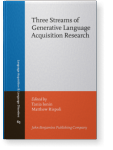Interpretation of count and mass NPs by L2-learners from generalized classifier L1s
Tania Ionin | University of Illinois at Urbana–Champaign
This study investigates whether L2-learners from generalized classifier (GC) languages (Korean and Chinese) can acquire the count/mass distinction of English, in the domain of singular NP interpretation. We hypothesize that L1-Korean/Chinese L2-English learners transfer the properties of NP interpretation from their L1 to their L2. This hypothesis was tested using a Picture-Matching Task (PMT). To confirm the L1-transfer effect, Korean and Chinese versions of the experiment were also administered. The results of the English study show that L1-Korean/Chinese L2-English learners were target-like with count NPs, but allowed object-readings of mass NPs more than English NSs. The results of the Korean and Chinese experiment versions provide possible evidence that the pattern of results obtained for L2-English is due to L1-transfer from Korean/Chinese.
Article outline
- 1.Introduction
- 1.1Cross-linguistic variation in the count/mass distinction
- 1.2Motivation for the present study
- 2.Experiment 1: English study
- 2.1Tasks and procedure
- 2.1.1Picture-matching task (PMT)
- 2.1.2Cloze test
- 2.2Participants
- 2.3Results
- 2.4Discussion
- 3.Experiment 2: Korean and Chinese studies
- 3.1Participants and tasks
- 3.2Results
- 3.3Discussion
- 4.General discussion and conclusion
-
Notes
-
References
